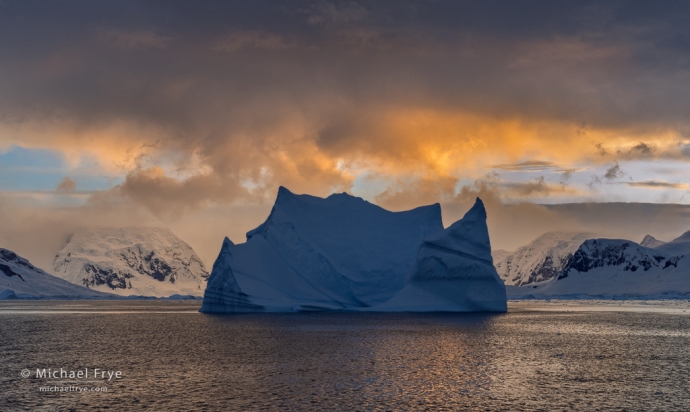
Iceberg at sunset, Antarctica. As if putting on a grand finale, we passed a large, beautifully-shaped iceberg just after sunset, with colorful clouds lingering in the sky to the south.
As I said in my last post, I had a wonderful and eye-opening introduction to Antarctica. But the next day, January 18th, would be even better.
By this second morning we were all starting to get used to the rhythms of life on board the ship, and our group had quickly gelled. We had a really great group, and had lots of fun together. And the crew members of the Hans Hansson were all super nice, going out of their way to make us all feel comfortable and give us the best experience possible.
The day began with overcast skies – which gave us a little extra sleep, since there wasn’t a compelling reason to get up for sunrise at 3:00 a.m.! But later in the morning skies started to clear.
Our route that day would took us to Cierva Cove, then Charlotte Bay. We stayed on the ship all day, with no landings or zodiac cruises – the only day we did that. But what we saw from the ship was incredible.
First we passed some giant icebergs, then saw our first humpback whales; they passed right under the ship. That was the first of many, many whale sightings – they were everywhere.
Cierva Cove brought striking mountain scenery, with sun starting to break through and light the peaks, and more icebergs:
Then more whales, beautiful ice formations, our first leopard seal sighting, and penguins on icebergs. As we exited the cove a giant tabular iceberg came into view. The wind was calm, the water smooth, and at one point some beautiful ripples appeared in front of the berg:
Icebergs like this are too large to have just calved off from a local glacier. They’re parts of distant ice shelves that have broken off and drifted into the area. The nearest ice shelf was at least 250 miles away, but this iceberg could have come from much farther.
As we were heading toward Charlotte Bay I noticed a beautiful ice arch in the distance on our port side. I pointed it out to my co-instructor, Chris Linder. Chris had done this trip several times before, and had lots of Antarctic experience. These ice arches are ephemeral, and he thought this might be the best arch we would find on the trip (he was right about that). So we talked to our captain, Julian McGale, to see if we could make a detour to the arch.
Julian thought it would be about a 45-minute detour to go to the arch. That would get us to Charlotte Bay later, but we thought it would be worth it.
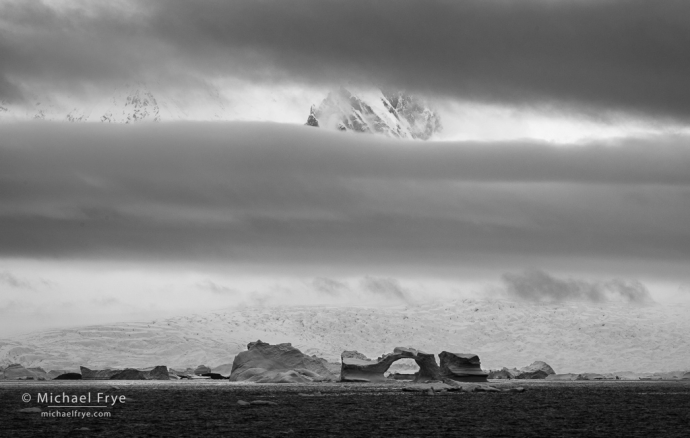
Mountains, clouds, and ice arch, Antarctica. As we approached the ice arch, mountains appeared briefly through the clouds above.
The ice arch turned out to be closer than it looked. We got everyone out on deck to photograph it, and our first mate, Voy, who was piloting the ship at the time, circled the berg three times for us. He even asked if we wanted to be closer or farther away on each pass. Circling the berg three times gave everyone multiple chances, and the ability to capture a composition they missed the first or second time around.
This was one of the big advantages of being on a small ship, with only our group on board. We could make detours if something interesting caught our eye. We could modify our schedule if necessary to take advantage of interesting conditions, or sightings. And we could go places larger ships can’t go – something that became apparent later in Charlotte Bay.
There were limits, of course; a change in schedule now might mean missing something else later, so it was a juggling act. And the crew needed time to rest. But they were very accommodating and flexible, which we were very grateful for.
After the iceberg arch we continued toward Charlotte Bay, passing through a narrow channel between an island and the peninsula mainland.
We emerged onto the southern edge of the Gerlach Straight, with the mountains of Brabant Island across the straight in the distance. These mountains would remain visible for the rest of the day as we journeyed down into Charlotte Bay and out again, with light and clouds playing on the flanks of those mountains, providing wonderful backdrops to work with.
Julian thought that ice conditions in Charlotte Bay could be good – and he was right. There was ice everywhere, with large, medium, and small icebergs, brash ice, “bergy bits” – the whole gamut. This was too much ice for a larger ship to navigate, but the Hans Hansson could maneuver its way between the icebergs and deep into the bay.
We made a large, sweeping, U-shaped curve through the bay, down the east side, then back up the west side, passing one stunning scene after another.
At first the sun was only hitting distant peaks and clouds to our north and west. Then sunbeams appeared to our west. Finally the sun broke through to light icebergs right in front of us, and then peaks to our south, and then east. As the sun dipped lower the colors got richer, and kept going and going through the long, lingering, Antarctic sunset.
Icy foregrounds appeared and disappeared as the ship slipped through the ice. Finally, as if giving us a grand finale, we passed a large, beautifully-shaped iceberg, and those of us still on deck photographed it against sunset clouds to the south. That’s the photo at the top of this post; here are some of the images I made earlier on that wonderful afternoon and evening:
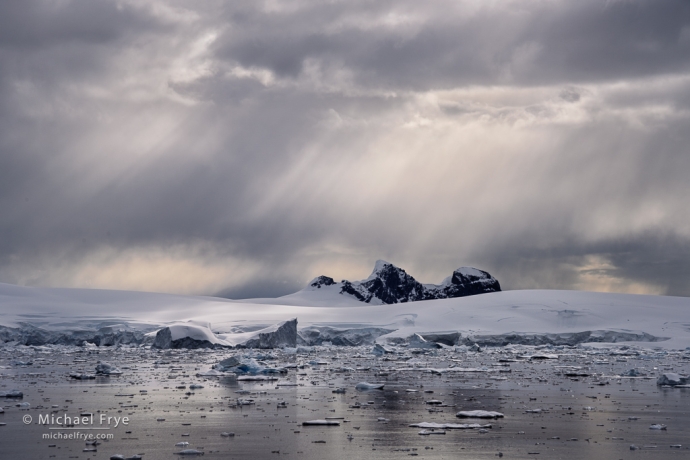
Sunbeams, mountains, and icebergs, Antarctica. The sun started to break through, lighting icebergs and creating sunbeams.
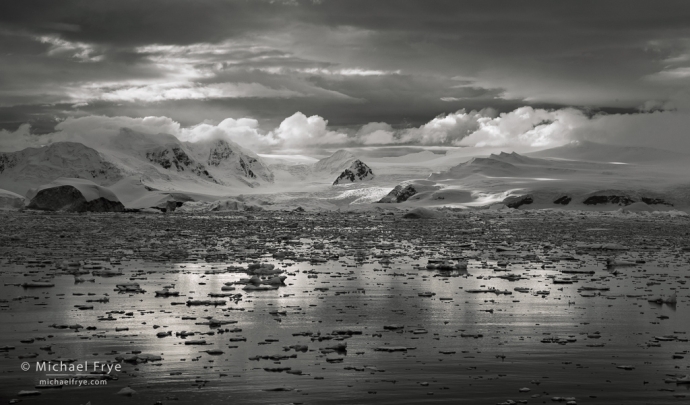
Clouds and mountains in an icy bay, Antarctica. The light at this moment was stunning. This might be my favorite photo of the day.
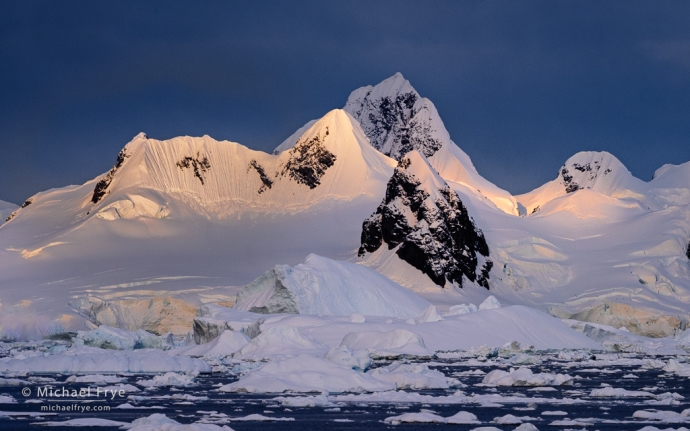
Sunlit peaks, Antarctica. Looking east toward some dramatic peaks. At this point there were wonderful views in every direction.
When it finally got too dark to photograph I stepped inside to warm up on the bridge. All hands were on deck helping to navigate through the ice in the gathering dusk. But with skill and care we made it out of the bay safely and motored to our anchorage for the night.
What a day it had been! One of the most memorable days of photography I can remember. We passed through endlessly magnificent scenery, and the light kept getting better and better, culminating in a long, beautiful Antarctic sunset.
I’ve posted many photos here from that day, and I could have included more. It was really hard to narrow it down. But that’s a nice problem to have. It was such a fun day!
— Michael Frye
P.S. I’m thrilled to be going back to Antarctica next year – and you can join me! I’ll be co-leading this expedition with Visionary Wild founder Justin Black, January 1-17, 2026. We’ll be aboard the same ship, the Hans Hansson, with a similar itinerary to the trip I just completed.
There’s no doubt that Antarctica trips are expensive, but if you’re an enthusiastic photographer this is the way to go. While many trips spend only five days actually in Antarctica, we’ll be there for nearly two weeks. And, as I described, we have the flexibility aboard our small ship to adjust our route, take advantage of conditions and unexpected photo opportunities, and go places larger ships can’t reach.
And you can also join me in Greenland this September! On this Visionary Wild trip we’ll again be the only party aboard a small (though slightly larger!) vessel, the beautiful three-masted schooner Rembrandt van Rijn. Chris Linder will again be one of my co-instructors, along with my good friend Jerry Dodrill. I’m really looking forward to sailing through the beautiful, iceberg-filled fiords of Greenland – can’t wait! And I hope you can join us!
P.P.S. Wherever you’ve been this winter, I hope you’ve been making photographs you love. But how do you make your favorite images truly express what you were hoping to convey when you pressed the shutter? To me, a big part of that – of communicating your photograph’s message, story, and vision – is making local adjustments to direct the viewer’s eye. Where do you want people to look? What do you want to emphasize? How can you tone down areas that might distract from your message?
I’ll be discussing and demonstrating how to do that in my upcoming Lightroom Webinar: Painting With Light, on March 8th. If you haven’t signed up yet, there’s still time! You can find out more and register here. (And if you can’t attend live, the webinar will be recorded so you can watch it later).
Related Posts: My First 36 Hours in Antarctica; A Quick Note From Antarctica
Michael Frye is a professional photographer specializing in landscapes and nature. He lives near Yosemite National Park in California, but travels extensively to photograph natural landscapes in the American West and throughout the world.
Michael uses light, weather, and design to make photographs that capture the mood of the landscape, and convey the beauty, power, and mystery of nature. His work has received numerous awards, including the North American Nature Photography Association’s 2023 award for Fine Art in Nature Photography. Michael’s photographs have appeared in publications around the world, and he’s the author and/or principal photographer of several books, including Digital Landscape Photography: In the Footsteps of Ansel Adams and the Great Masters, and The Photographer’s Guide to Yosemite.
Michael loves to share his knowledge of photography through articles, books, workshops, online courses, and his blog. He’s taught over 200 workshops focused on landscape photography, night photography, digital image processing, and printing.

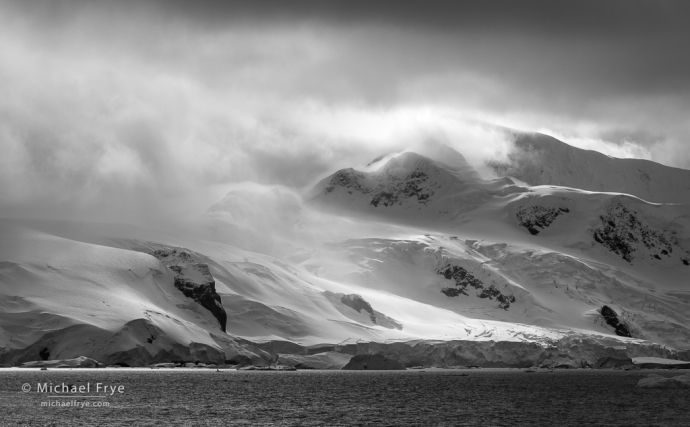
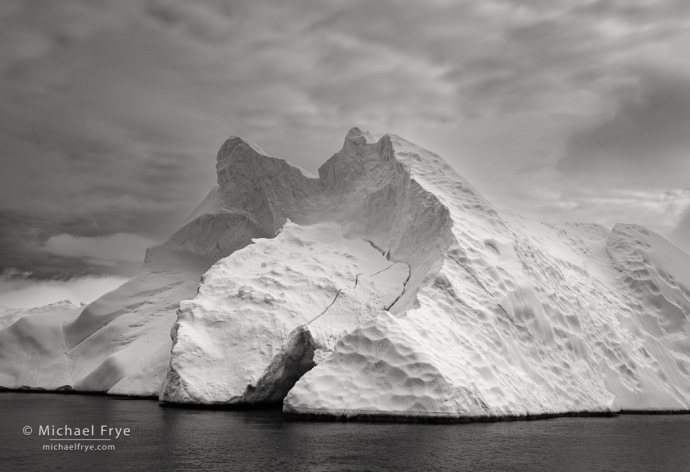
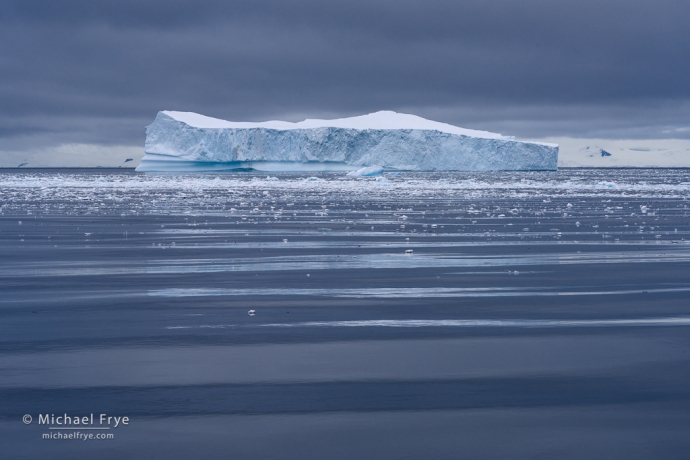
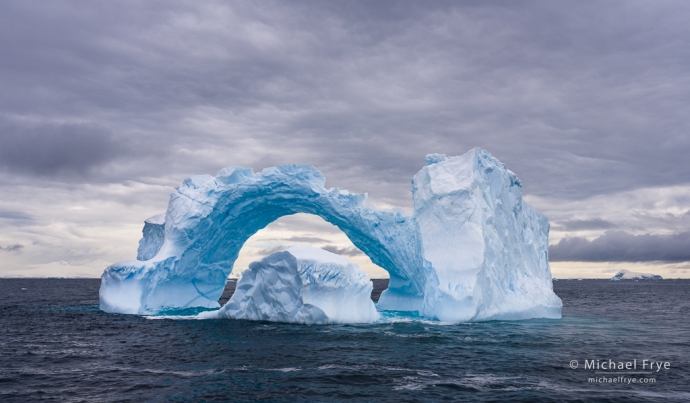
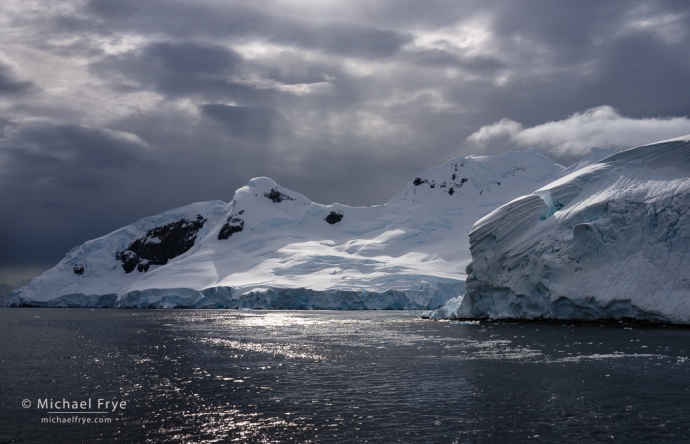
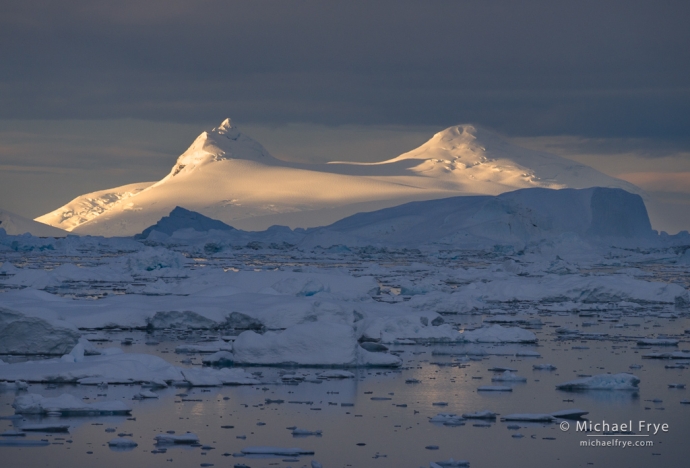
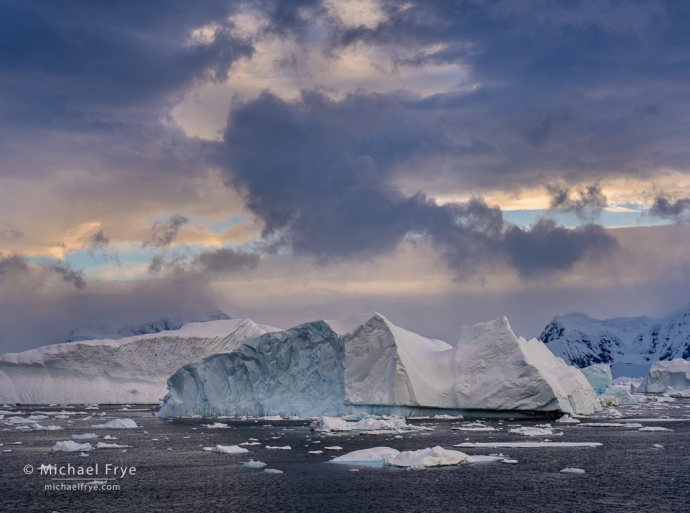
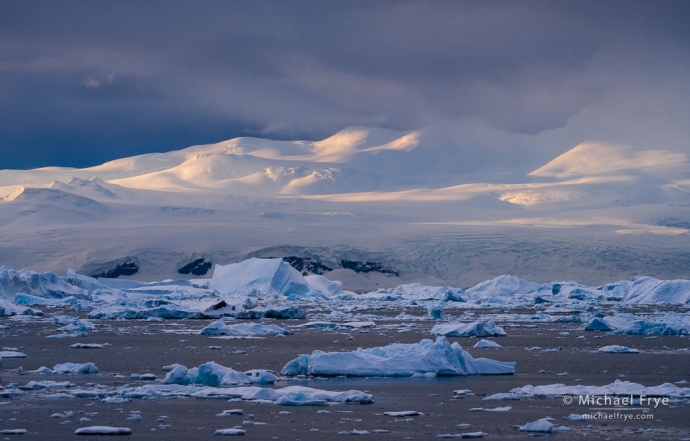






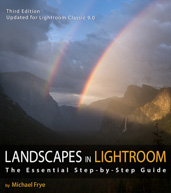
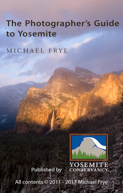
Hi Michael,
Thanks for allowing us to vicariously experience Antartica through your images and words.
I have to agree about the one you said was your favorite. I stopped and looked at that one for quite a while. It’s a truly stunning image.
Thanks Doug, and I’m glad you like that image too!
Exciting images and stories. Thank you. Did you have a gear weight limit, and if so, what did you decide to take?
Thanks Gery! We did not have a weight limit, other than the usual airline restrictions (50 lbs. for a checked bag, 26 or something for carryon).
What an incredible group of photos, Michael, just stunning. What an absolute thrill it must have been to stand on deck and watch these fantastic scenes emerge! I’m sure this must have been the trip of a lifetime for many of the participants—it certainly would be for me. Thanks so much!
Thank you for this blog Michael, stunning photos and cool stories of life on board the Hans Hansson.
We hope to join you in 2026!
Thanks very much Don! It would be great to have you and Carmen with us!
Wow! Really stunning images and (selfish me) I’m looking forward to seeing more of your journey to this very remote place.
Thanks very much Gina!